If you’ve ever been to Vienna… then you’ll agree that there are many things to love about this city. And, one of the great things is the incredible Vienna architecture that is EVERYWHERE!
So, with the huge amount of buildings to see in Vienna, Paul and I went crazy taking photos. Plus, there were many different styles… with some of them art deco, gothic, baroque style and more!
Thus, in this We Drink Eat Travel blog… we’ll share with you 15 of the amazing Vienna buildings you can check out when you’re sightseeing. And, take note that these are structures which aren’t churches!
So, let’s get started…
Vienna Architecture – 15 Amazing Buildings To See That Aren’t Churches…
Hundertwasserhaus
When Paul and I were staying at the Hotel Ibis Wien Messe… we did a self-walking tour in Vienna of the Leopoldstadt D2 area. Then, just outside this area in District 3, is one of the famous buildings in Vienna.
And, this architectural masterpiece is called, Hundertwasserhaus…
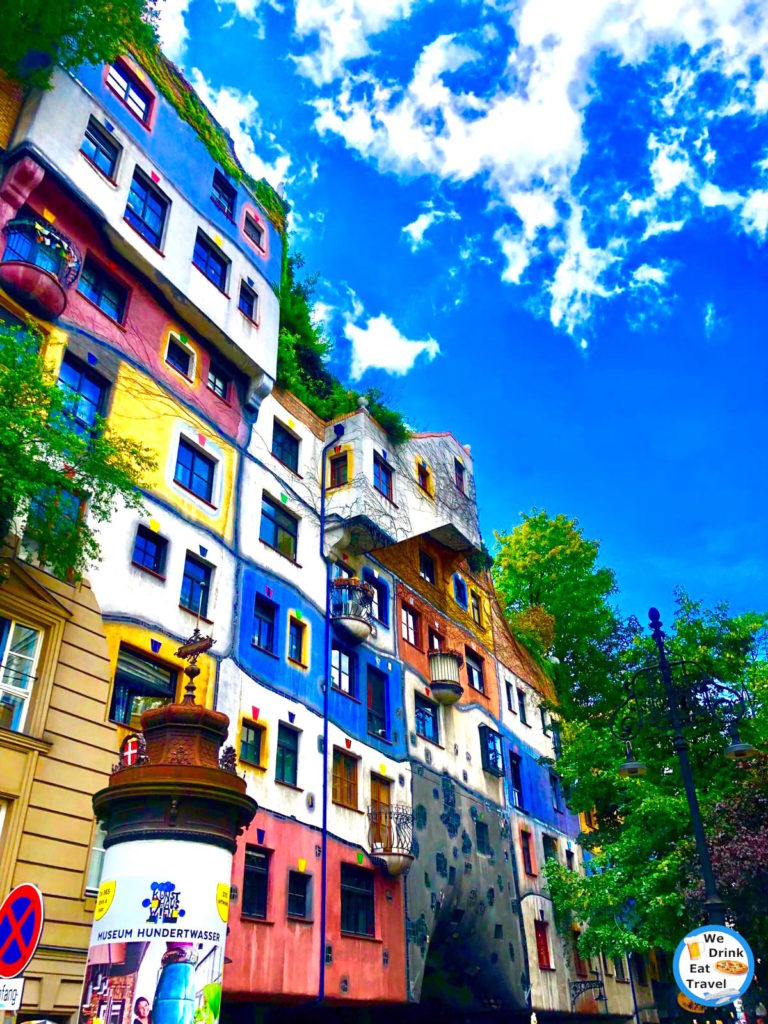
Hundertwasserhaus is a major tourist attraction, and you can see from the photo why it is so. It’s an odd looking colorful building, that is actually a residential block. It stands out compared to the buildings around it. Plus, it even has its own cute little village.
The designer of this striking, rainbow building was Friedensreich Hundertwasser, who was a painter. And, combined with his love of nature, he created the unique Hundertwasserhaus.
Even though it’s outside the city centre… we believe it’s one of the buildings to see in Vienna if you get the opportunity.
Palais des Beaux Arts
So, very close to Hundertwasserhaus is the Palais des Beaux Arts… established in 1908 on Löwengasse 47a Street.
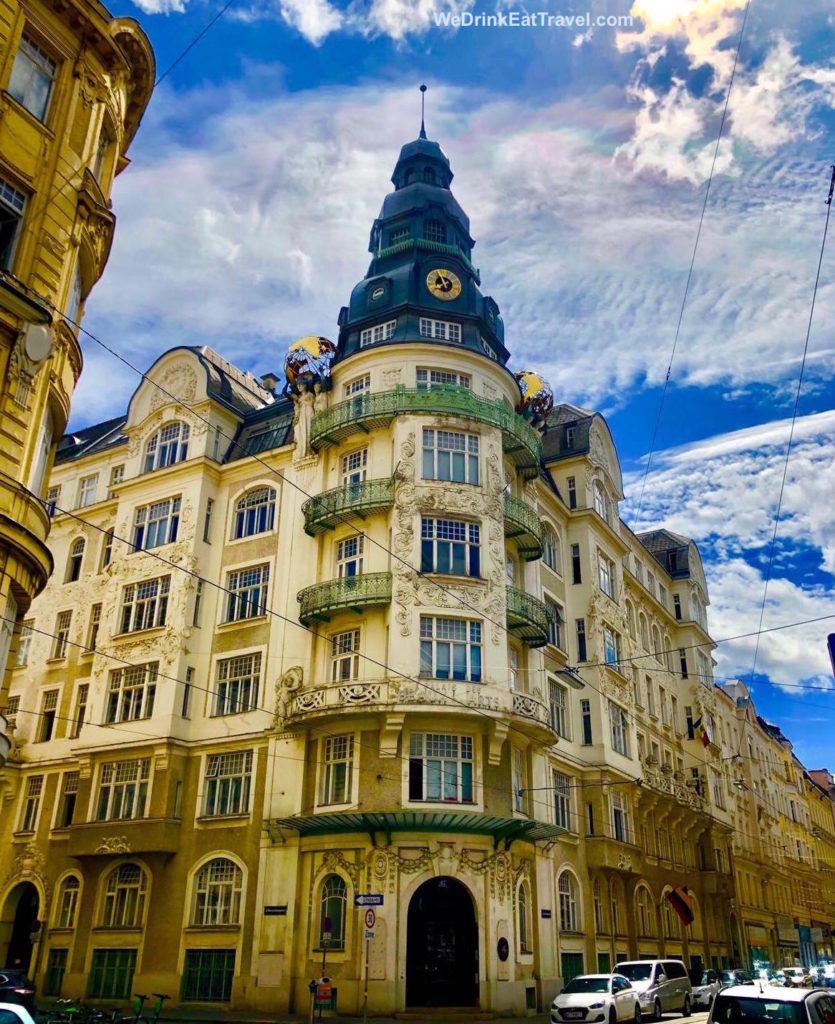
This building was constructed as a base, for international magazine publishing house Atelier Bachwitz / Bachwitz AG.
So, not only did it house printing facilities in the basement… there were apartments for the Bachwitz family, to embody the spirit of ‘Beaux Arts’.
Then, as the Palais des Beaux Arts building was under Jewish heritage… it was subject to the Nuremberg Race Laws from 1938.
So in the Palais des Beaux Arts, it housed digital, browser-based art and research on the histories of media.
And, with digital transformations from past to present… Bernhard Garnicnig and Seth Weiner share their stories of collaborative digital media publishing practices.
Belvedere Palace
When Paul and I were walking to see Belvedere Palace, we instantly knew that the area was huge… as it took a while to get from one corner to the actual entrance.
And, once we entered, we were met with a large, lush pretty garden… a central lake and this amazing view of the Palace…
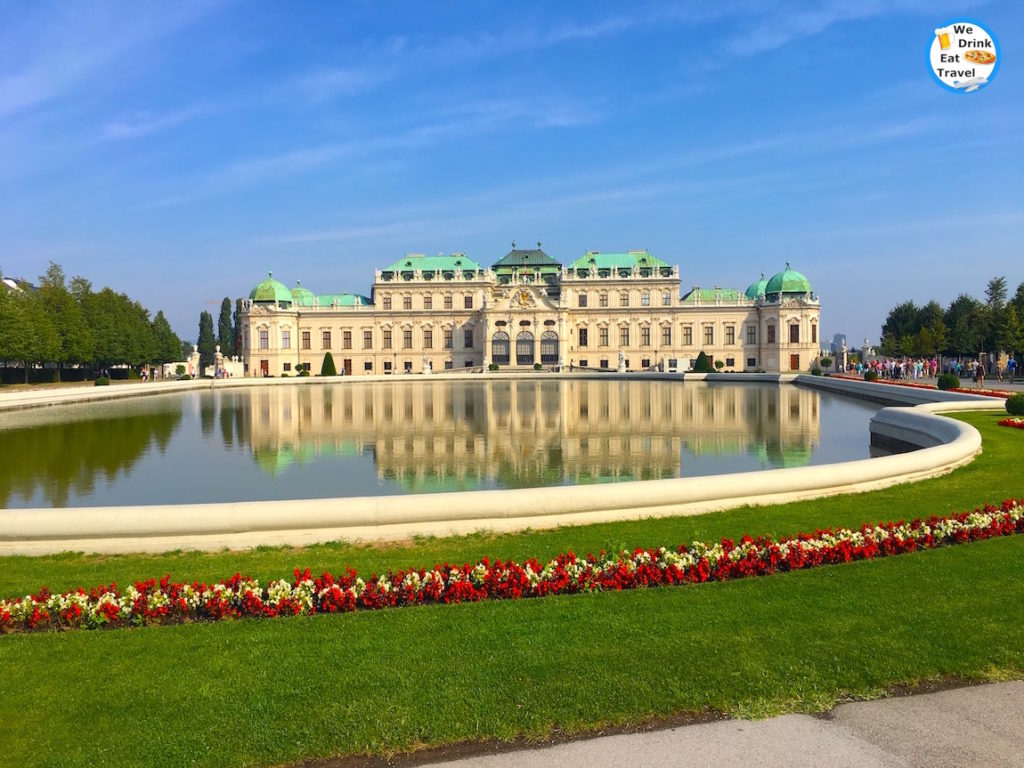
Yet, there’s more! That was the Upper Palace section, and there’s also a Lower Palace section too…
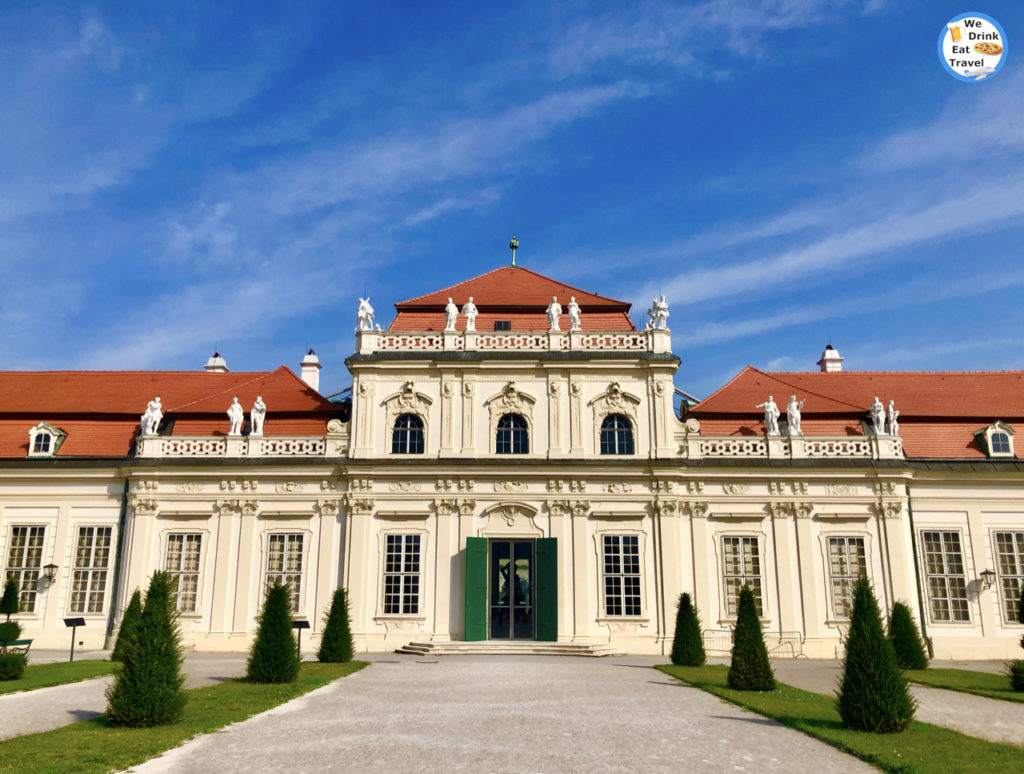
The two Belvedere Palaces, built in the early 18th century… were the summer residences of Prince Eugene of Savoy. These Baroque style Vienna architecture of these buildings… were designed by architect Johann Lucas von Hildebrandt.
If you’d like to pay to go inside… you can view a collection of Austrian art from the Middle Ages to the current time. Plus, there are works on display by a variety of international artists… as well as other attractions.
So, while the Belvedere Palace looks grand, there is another Palace that will make you go WOW!
Schloss Schönbrunn (Schönbrunn Palace)
Now, one of the famous buildings in Vienna is the Schönbrunn Palace. So, this building is a UNESCO World Heritage Listed site… and when we went there we could understand why.


This Palace was the main summer house of the Habsburg rulers, and inside it is Rococo styled. Plus, it has a ridiculous 1,441 rooms! But, to see inside you will need to pay an entrance fee.
Yet, even without going inside the Palace, there’s so much to see and do. And it’s that big that there are train tours that can be taken to get around…

Now, it makes you wonder why anyone would need such a huge place like this. But, if there’s the money to burn then why not!
So, while it’s out of the main city centre, this is definitely one of the buildings to see in Vienna.
Naturhistorisches Museum (Museum of Natural History) AND Kunsthistorisches Museum (Museum of Fine Arts)
The Museum of Natural History… is one of two magnificent architectural delights in the Maria Theresien Platz.
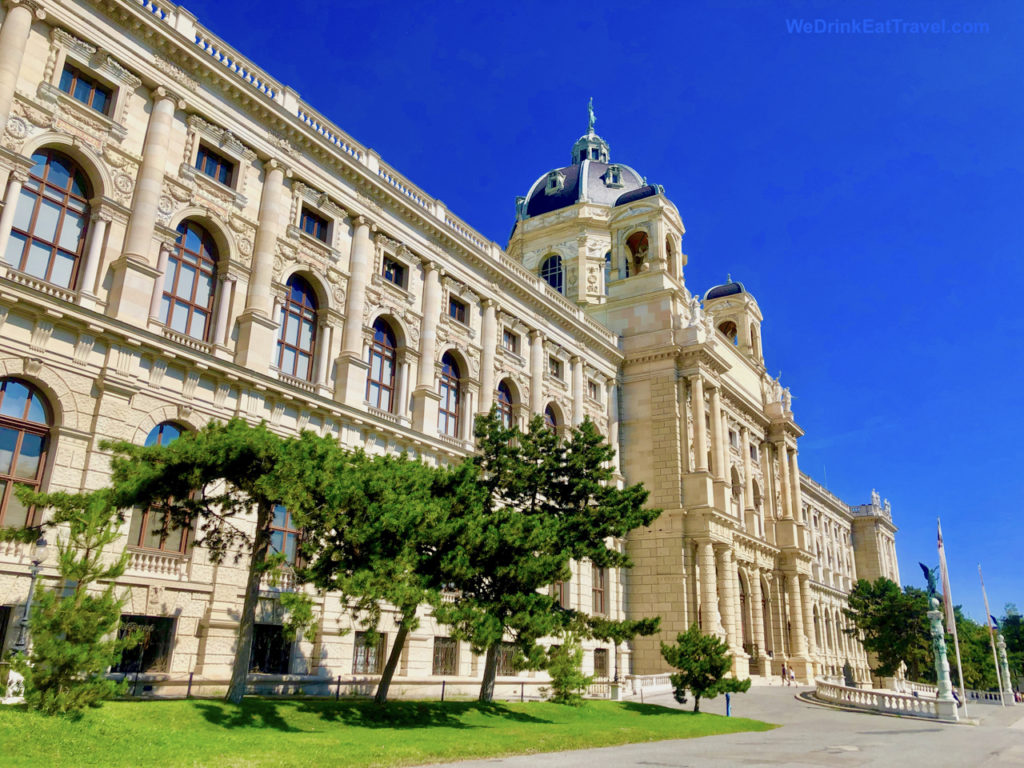
The design of the Natural History Museum was by architects, Gottfried Semper and Carl Hasenauer. Works on this Museum were from 1871 until 1881. Then, on 10th August, 1889 Emperor Franz Joseph I officially opened the museum.
The Natural History Museum’s façade, shows figures and statues representing progress in the field of natural sciences… and the power of nature.
This Museum is one of the most important in the world… as it is houses about 30,000,000 collections of natural history items. Plus, one of its most featured objects is the Venus of Willendorf… which they say is to be have been made about 29,500 years ago!
And, opposite the Natural History Museum, with equally grandiose Vienna architecture is… the Kunsthistorisches Museum (Museum of Fine Arts).
Like the Natural History Museum… the design of the Museum of Fine Arts was by architects Gottfried Semper, and Carl Hasenauer.
So, that’s why we’ve grouped these 2 museums together in one section… because the two museums look identical from the outside!
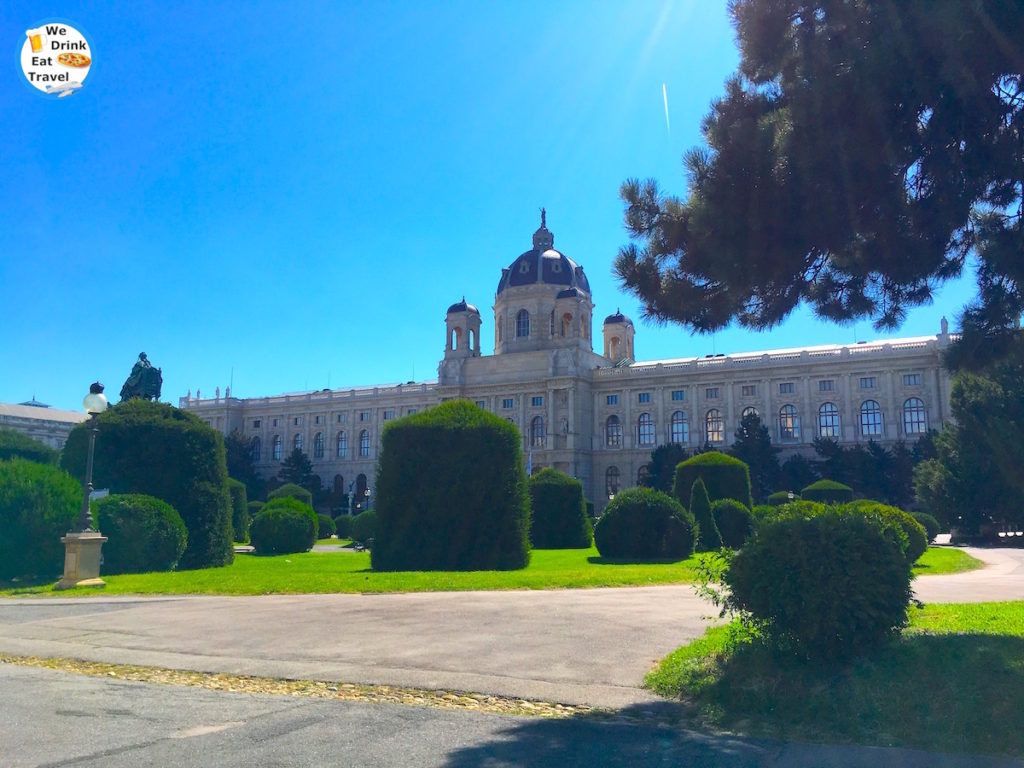
So, it’s said that the design of these 2 museums was to be part of a much larger project, called the Imperial Forum. Yet, this never eventuated in full. But, the construction of the Museum of Fine Arts was in the late 1800’s, with its completion in 1891.
The creation of the Museum of Fine Arts could then house the artistic treasures… that the Habsburg Empire collected over centuries.
So, while it looks amazing on the outside… you will need to pay to get into the Museum of Fine Arts and see its collections.
The collections range from Ancient Egyptian, Greek and Roman Antiquities… through to Medieval Art, and the Renaissance and Baroque.
MuseumsQuartier
Opposite the Maria Theresien Platz… we couldn’t miss the massive, light apricot colored complex of the MuseumsQuartier.
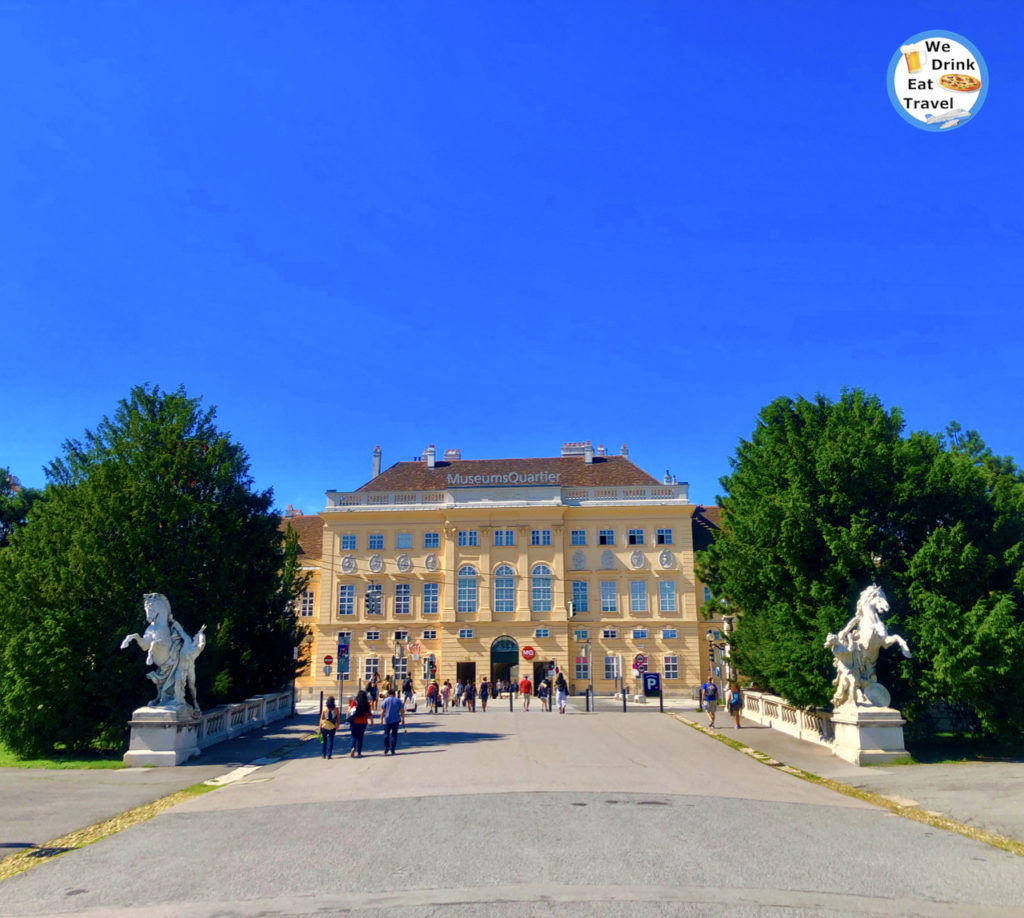
The MuseumsQuartier, which spans over 90,000m2… is one of the largest complexes for art and culture in the world.
The MuseumsQuartier was built in the 18th century from the designs of Johann Bernhard Fischer von Erlach… but was Vienna’s imperial stables. Then, from 1850 to 1854, the Winter Riding Hall was a new addition, which is now the MusemsQuartier main courtyard.
Then, in modernizing the area, new buildings were constructed to become the MuseumsQuartier that we see today… based on the designs by Laurids and Manfred Ortner.
So, the mix of the historic Baroque styled building with modern structures… provides a unique area to showcase ancient through to contemporary pieces.
Plus, in addition to the main courtyard, which has funky lounges to hang out… there are other small courtyard areas to relax, and have food and drinks.
So, with just over halfway through,… you can see how remarkable the Vienna architecture is, right? But wait, there’s more!
Rathaus (City Hall)
So another Gothic styled building with magnificent Vienna architecture… is the Rathaus, and it’s not a church!
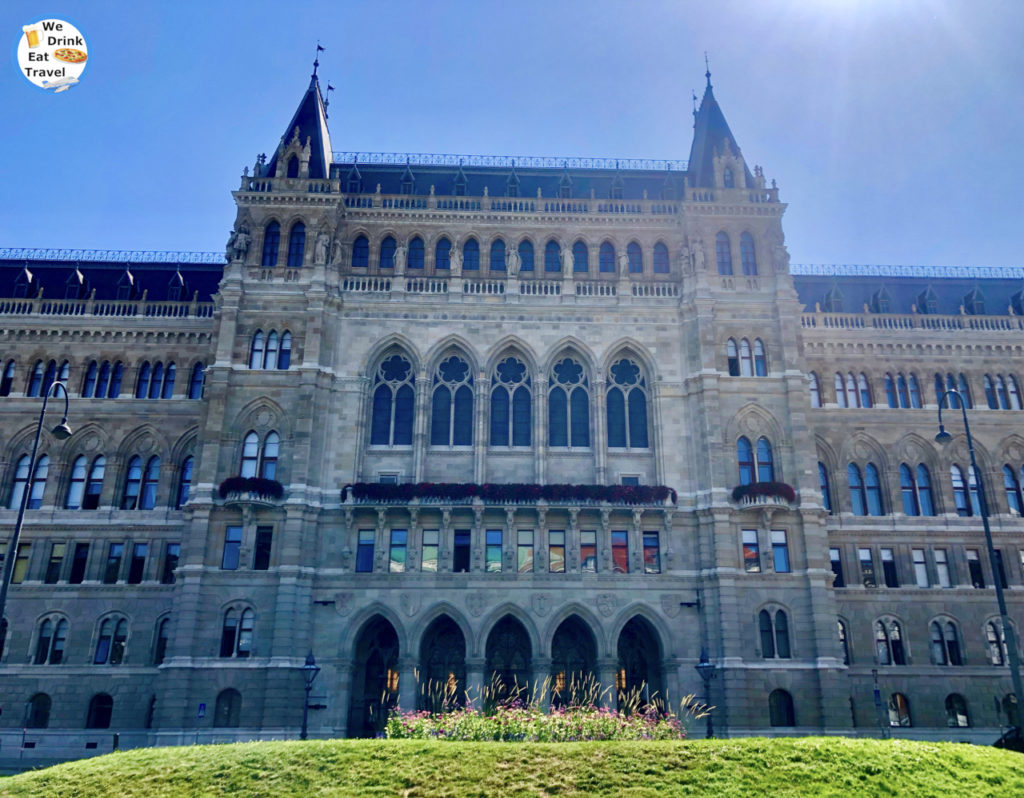
Vienna City Hall is the official seat of the Mayor. Plus, it’s the meeting place for the local city senate… as well as the provincial government, and the Municipal Council – Landtag.
The designer of the Vienna City Hall was Friedrich von Schmidt, and built in the late 1800’s.
And there’s a ginormous outdoor area… which has uses for different activities throughout the year. So when we were there, a lot of table, chairs and food stalls were set up… as well as a stage for a concert.
Burgtheater
Architect Gottfried Semper was again involved in a Viennese landmark, the Burgtheater.
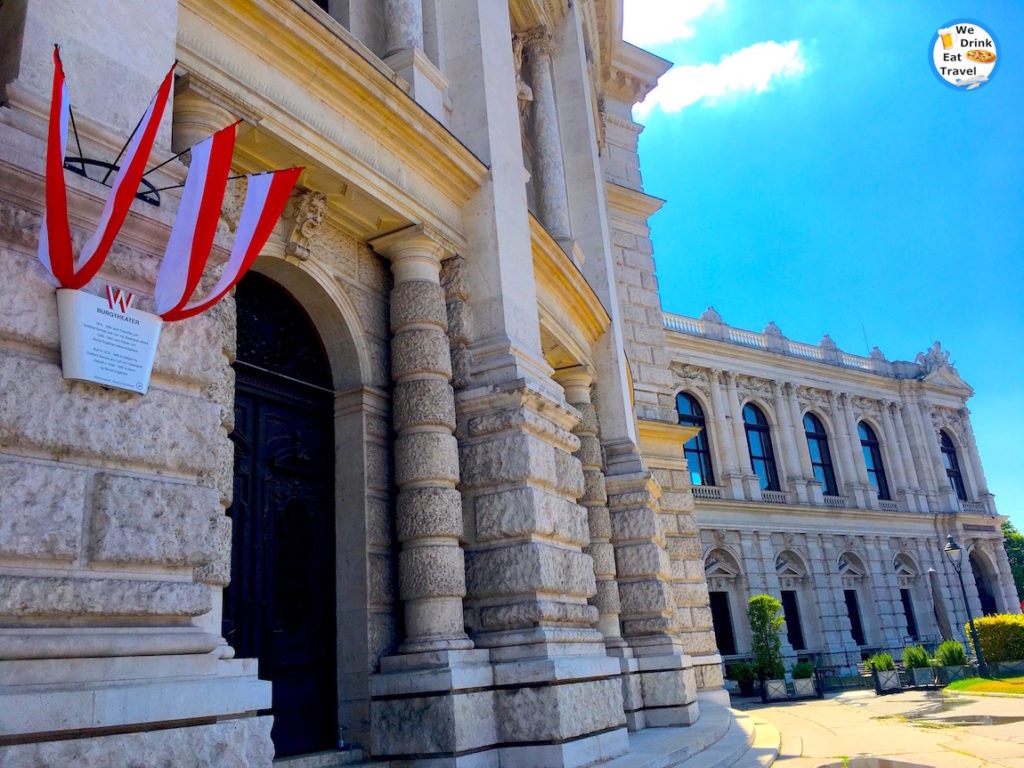
And, along with Karl von Hasenauer… they designed this remarkable theater that was re-built from 1874 to 1888.
So, the Burgtheater is not only the National Theater of Austria… it’s one of the most important German theaters in the world.
The original Burgtheater was established in 1741… as the Habsburg Empress, Maria Theresa of Austria, wanted a theatre near her palace! So nowadays, the Burgtheater showcases hundreds of performances each year.
Plus, you can take advantage of special ticket discounts throughout the year.
This certainly is another one of the buildings to see… with stunning Vienna architecture.
Albertina Museum
The Albertina was built in the second half of the 17th century, but as the Court Construction Office. Yet, since then due to Imperial modifications and the war… the Albertina underwent refurbishment to what we see today.
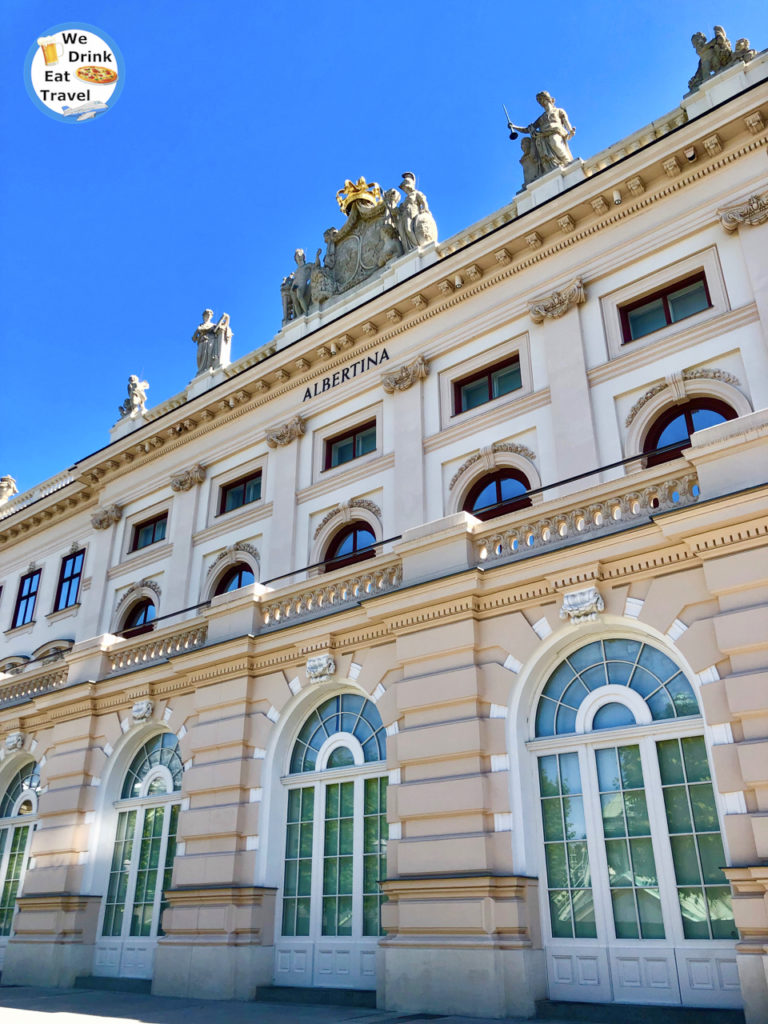
The Albertina includes a museum… which houses about 60,000 drawings and one million prints! But due to their light sensitivity, these works cannot be on permanent display.
So, there are other permanent exhibitions like Monet to Picasso… as well as other temporary exhibitions throughout the year.
Yet, not only is the Albertina a museum… this building was also the residential palace for former Imperial families.
Plus, there’s an outdoor area at the top… which is a great place for taking photos of other buildings like the State Opera House.
And, the 20 luxurious State Rooms within the palace, can be viewed within the building for a fee.
State Opera House
The Renaissance-styled Vienna architecture of the State Opera House… is another one of the famous buildings in Vienna city, dating back to 1869. And, when looking at it from the Opernring Road… the original structure has been preserved since that time.
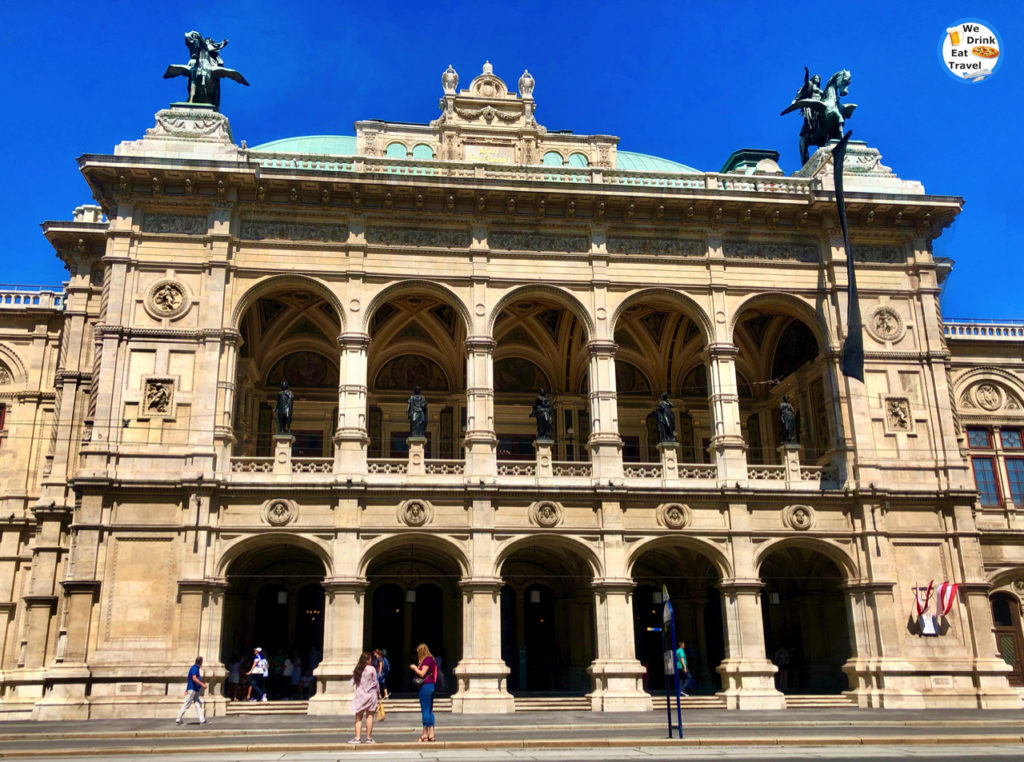
The structure of the State Opera House was planned by August Sicard von Sicardsburg… and the inside was designed by Eduard van der Nüll. Together with other artists, they created the Opera House that was opened on 25 May, 1869.
So in the State Opera House, there are 350 performances each season… with more than 60 different operas and ballets.
And, world famous artists perform along with the Vienna Philharmonic Orchestra… to make it a magical experience.
Hofburg
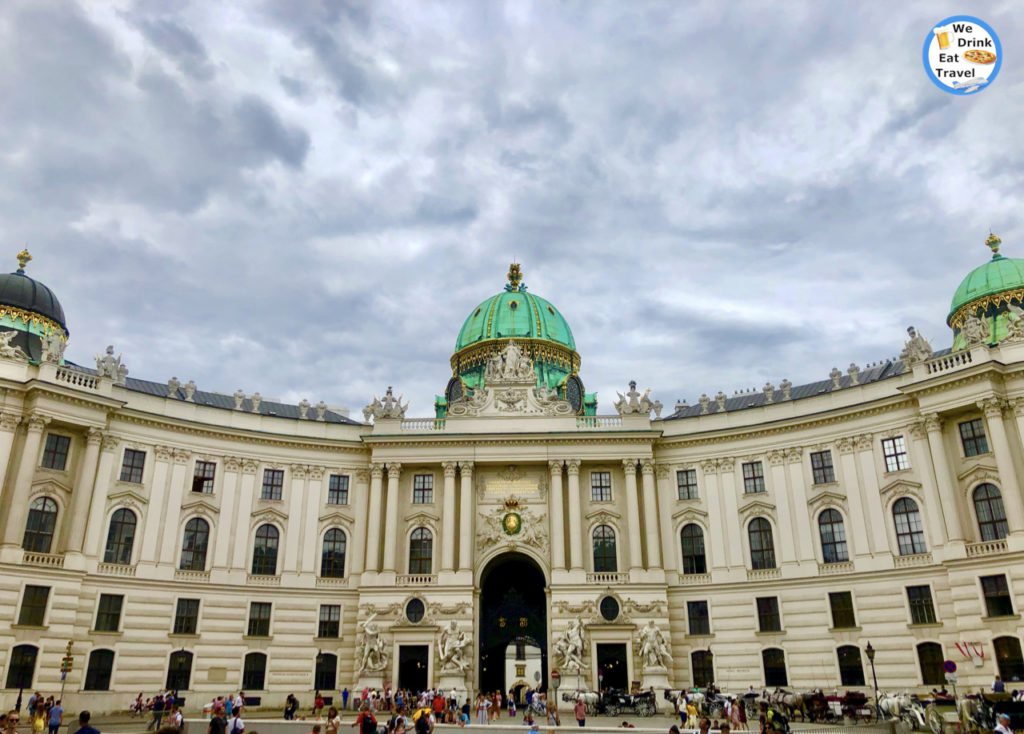
The Hofburg was the former main palace of the Habsburg Empire. Yet, today it’s the official residence and workplace of the President of Austria.
So, this majestic building was established in the 13th century… but as a medieval fortified castle. And over time, it has been extended and refurbished showcasing incredible Vienna architecture… including Baroque styled extensions designed by Johann Bernhard Fischer von Erlach.
So, the entire complex covers over 240,000 m²! And, it has 18 wings, 19 courtyards and 2,600 rooms, where nearly 5,000 people still work and live today.
Plus, in one part of the Hofburg was a basement area that was the wine cellar, which covered 3 floors. Is that the epitome of luxury or what?!
And, with this building being ginormous, it also houses the Austrian National Library.
Österreichische Nationalbibliothek (Austrian National Library)
In the Hofburg Palace is the magnificent Vienna architecture… of the Austrian National Library. And, the photo below is at the entrance on the street called, Augustinerstrasse.
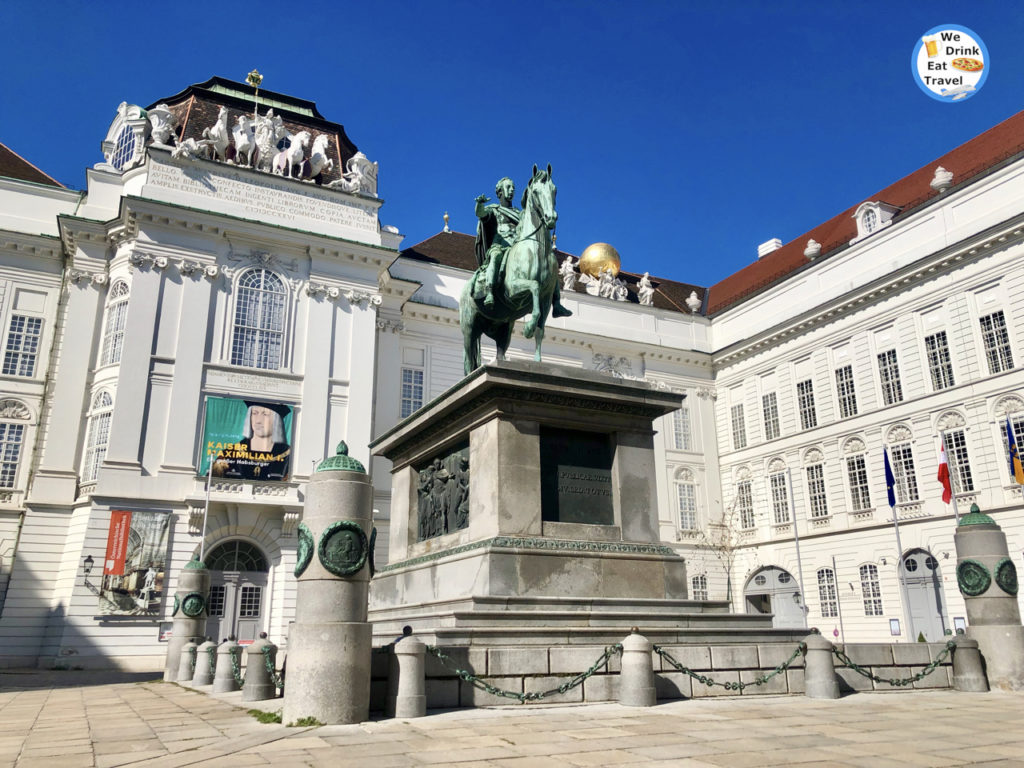
And in fact, it is in one of Vienna’s most finest courtyard’s Josefsplatz, or in English is Joseph’s Square. So, when we were there it was busy! Thus, getting photos without people in it was challenging!
And, the statue in front of the Library is of Emperor Joseph II, which was by sculptor Franz Anton von Zauner. He was commissioned by Emperor Francis II to create the statue in memory of his uncle… and to portray him as a Roman conqueror.
Regensburger Hof
Before the Regensburger Hof building was built, in its place was a building that had been re-built several times since the 14th century. And here, many meetings and commercial trades took place between merchants in this “warehouse.”
Then, in 1897, based on the designs by Franz von Neumann, there was the creation of a department store.
Then, in the 1990’s, there was further redevelopment of the Regensburger Hof… with the Vienna architecture we see today.
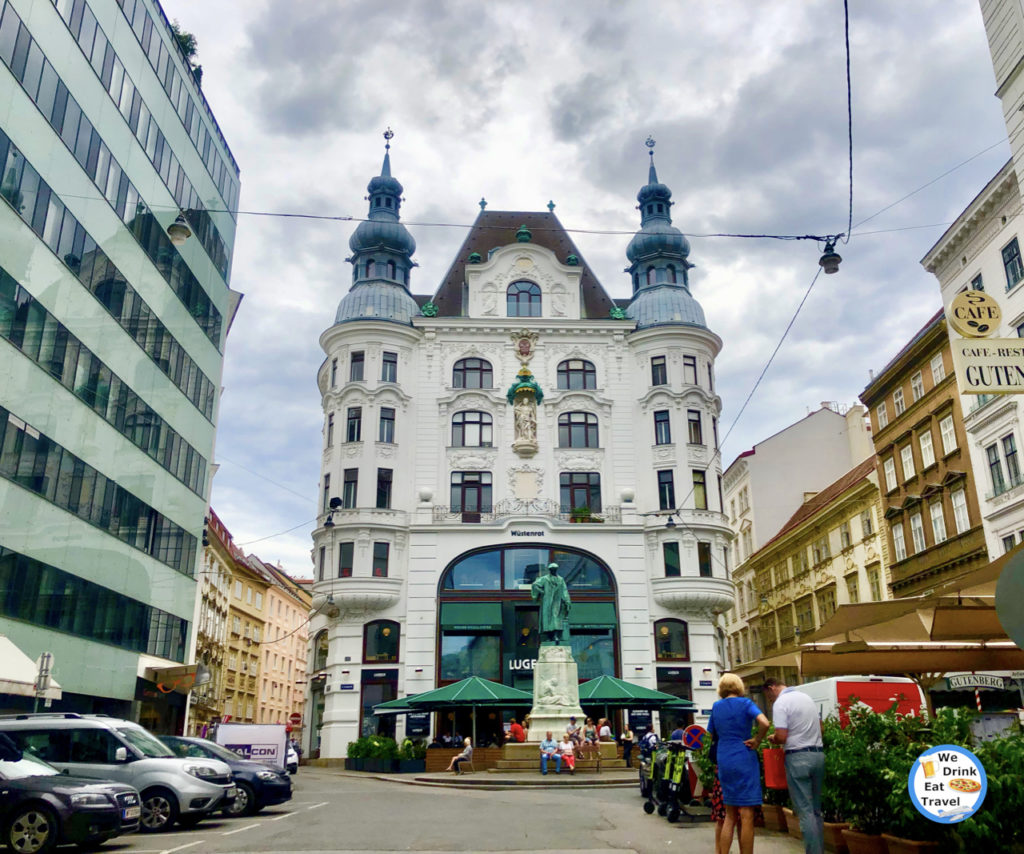
And, in front of the Regensburger Hof is monument of Johannes Gutenberg. So, he made a significant impact on the world… because he was the inventor of the mechanical printing press machine.
Palais Equitable
The Palais Equitable in Stock-im-Eisen-Platz, has a large prominent eagle near its rooftop.
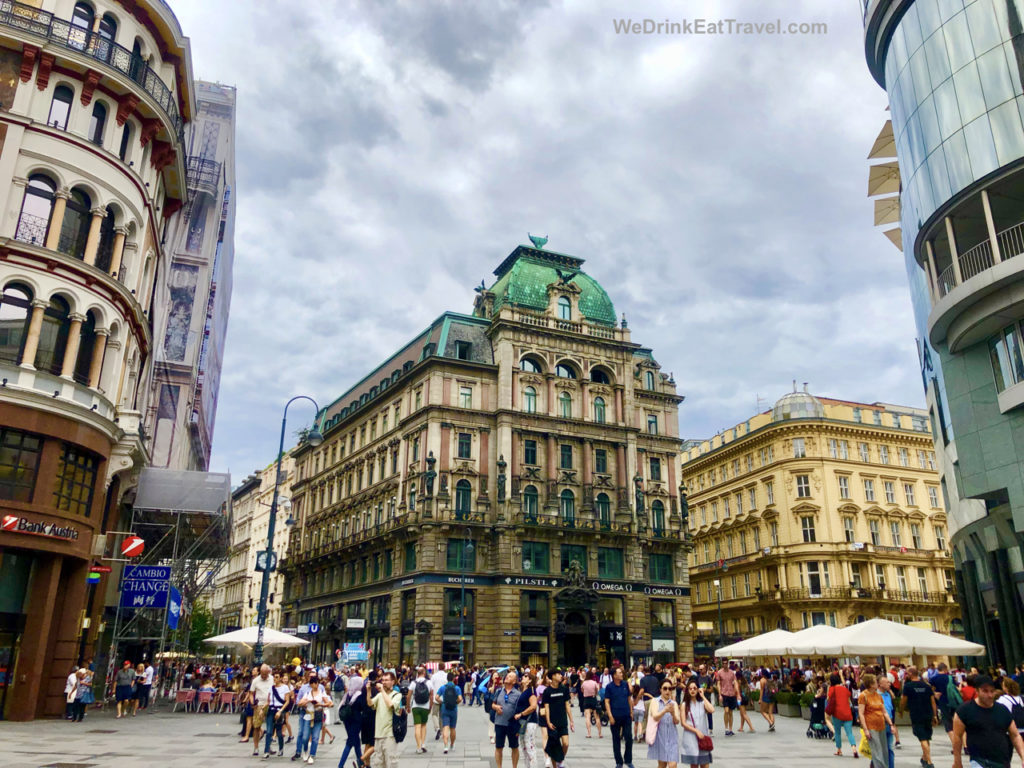
So, the construction of this palace was in the late 1800’s… for The Equitable Life Assurance Society of the United States. Hence, the reason for the American eagles constructed as part of the building.
And, even though the name suggests that this building was a palace… it is in fact one of the few mansions/palaces in Vienna, without ever being the residence of aristocrats.
So, nowadays the Palais Equitable is in use by various companies… as well as the porcelain manufacturer, Augarten. And, its location in Stock-im-Eisen-Platz is an historically important one, as we’ll explain soon.
Graben
Graben is one of the most popular and bustling streets in Vienna. And, it’s history dates back to the Roman times, where most of the buildings are from the 17th and 18th century.
Here in Graben street, not only is it a shopper’s paradise, it is an architectural mecca as well.
So, everywhere we looked around Graben street we saw such amazing and charming buildings. And, in this street is this memorial called the Plague Column.

This Baroque style monument was erected after the Great Plague that devastated Vienna in 1679.
And, the Plague Column has the Holy Trinity, nine Choirs of Angels and a kneeling Emperor Leopold. So, even behind the Plague Column you can see beautiful buildings.
Plus, you can start your journey along Graben Street from the Palais Equitable. So, take your time to stroll down the street… stop for a coffee, cake or ice cream and admire the amazing architecture.
So, having gone through 14 magnificent buildings showcasing the Vienna architecture… it was difficult to restrict it 15. Thus, this last one is a little different…
So, while we’ve covered 15 buildings to see in Vienna with amazing architecture… be assured that there are HEAPS more. That’s one thing we love about Vienna, is that there are so many architectural delights to see.
We trust this gives you a taste of what to see in Vienna, and hope you enjoy your travels!
You Might Be Interested In This Too..
What To Do In Wachau Valley Austria
How To Get From Vienna To Wachau Valley
Is Dubrovnik Worth Visiting? Fascinating Facts You Need To Know
How To Get From Vienna Airport To The City Centre
Want To Indulge In The Historic Sacher Cake In Vienna? Read This First!
One Of The Best Restaurants In Vienna For Traditional Food